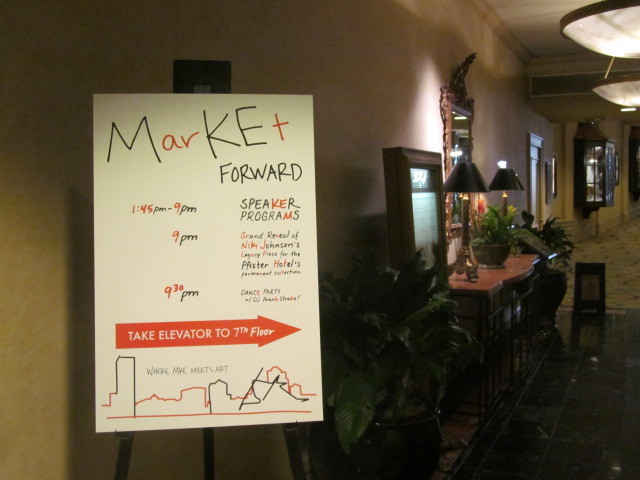
Good afternoon, Internets! I’ll be recapping the afternoon’s events at MarKEt FORWARD, a daylong symposium about how to be an art “professional”—you know, how to deal with art and suits. The MarKEt—the M,K, and E are capitalized for MKE (Milwaukee)—conference was organized by Niki Johnson and Kayle Karbowski as part of Johnson’s residency program at the Pfister Hotel. Right now, I’m sitting with the MacBook Army (Kate Sierz, Pepper Kelly, and Sid Branca) under Romanesque chandeliers. We came up with #market15, so you can keep up with us over on Twitter, too.
And, yes, we’re a bit skeptical of any symposium that brings up art as a means of “thinking outside the box.” Enjoy.
1:45 – 2:00 p.m., Welcome With MarKEt, artists Niki Johnson and Kayle Karbowski
Niki Johnson and Kayle Karbowski talk about why they started MarKEt, a new nonprofit devoted to helping artists in MKE make a living.
Johnson brings up how she wants artists to get to know collectors better, and wants MarKEt to work on connecting local artists with local collectors.
“The collectors are heading to the coasts to collect work,” she says, “and going to the coasts to collect it, too.” This is the second time I’ve heard this within the past 12 hours, that collectors aren’t even going to Chicago. Just the fairs and larger events in Los Angeles, too, I guess.
But here’s some questions I have for anyone in Milwaukee: Are collectors really going to Los Angeles? Are they skipping out on Chicago entirely?
[Note: Paul Germanos alerted me to a Brooklyn Rail interview with famous Milwaukeean Michelle Grabner, where she mentions collectors heading to New York.
Grabner: To maintain a rigorous art practice here, artists need to set their own criteria, continuously measuring and contextualizing their work. And this is more difficult than one might think because, unlike New York, Chicago is shockingly slight on critical, economic, and professional support….And they go to New York to buy the majority of their work, as they should. ]
@nikileejohnson and Kayle Karbowski kicking of #MarKEt15 at @PfisterHotel pic.twitter.com/7s9JkYOctA
— Kate Sierzputowski (@KateSierz) March 27, 2015
2:00 – 3:00 p.m., Grant Writing Unmasked, Melissa Dorn Richards 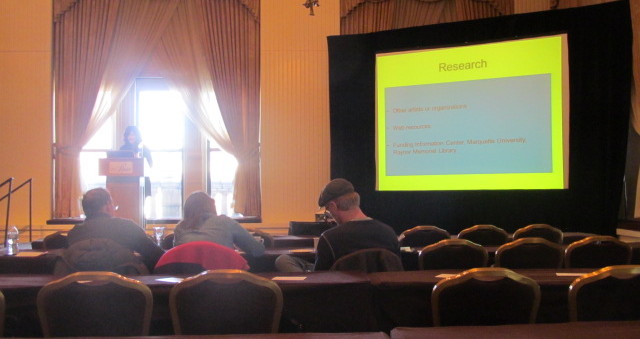 Are artists dumbasses? The impression I got out of this talk is that artists are really bad at reading instructions. Here’s some real-deal tips from the talk:
Are artists dumbasses? The impression I got out of this talk is that artists are really bad at reading instructions. Here’s some real-deal tips from the talk:
- Read the instructions twice, at a minimum. And that’s only before you begin writing.
- And if there’s an FAQ section as well, read that as well.
- Gather your work samples early. (You may think you have a good image, but it might not be as great as you remember.)
- Remember to submit the mid-term or final report!
- Take a Creative Capital webinar.
Of course, based on the number of hands raised, it does seem like the audience needed these tips. Here’s one neat thing that I wish we had in New York: the Milwaukee Artist Resource Network (MARN), lets you make a tax-deductible donation to an artist—without that artist needing a fiscal sponsor like New York Foundation for the Arts (NYFA). Yep. Fewer bureaucratic hoops to leap through, just for a donation.
have someone else look at your work sample images & see how they read is so obvious but o god actually do that #market15 #ionlysubmitselfies
— Sid Branca (@sidbranca) March 27, 2015

Creative Capital uses Gchat.
Hey, MKE. Creative Capital knows you’re talking about them.
3:00 – 4:00 p.m., Public Art: Place and Community, Jill Sebastian 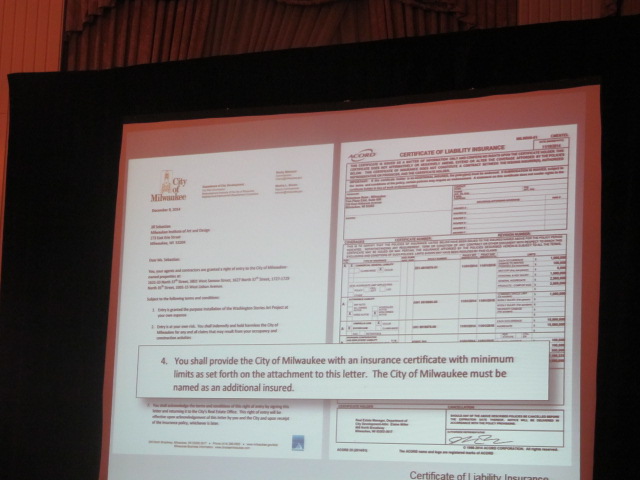 Jill Sebastian knows about public art; she’s been making and teaching public art in Milwaukee for years. Thank god she has a wry sense of humor. She’s so hardcore she’s made poop sculptures. Also, her talk is full of vivid Midwesternisms—”They can’t get blood from a turnip”—that are so, so good.
Jill Sebastian knows about public art; she’s been making and teaching public art in Milwaukee for years. Thank god she has a wry sense of humor. She’s so hardcore she’s made poop sculptures. Also, her talk is full of vivid Midwesternisms—”They can’t get blood from a turnip”—that are so, so good.
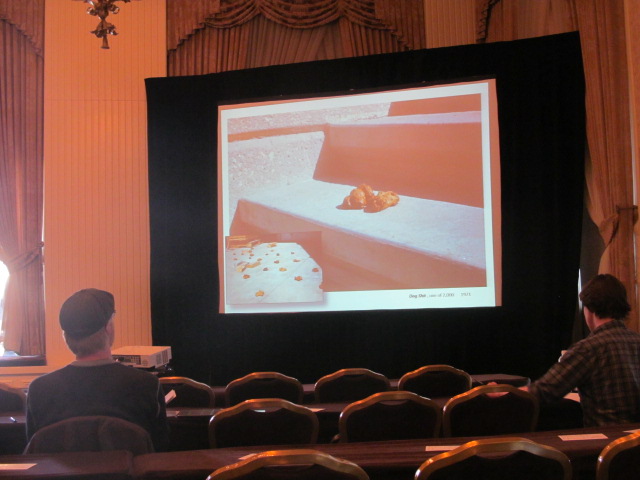
Jill Sebastian’s decades-long public art project. That’s fake dog poo.
The main takeaway from Jill’s talk: it’s okay to ask to get paid. Truth. Some tips on how to get paid:
- Never give a proposal, or RFP, to a city contractor without attaching a contract to it as well. There was a scandal, she mentions, regarding the Milwaukee Vietnam Veteran’s Memorial. City officials reviewed various proposals from artists, then took piecemeal ideas from each proposal before hiring a commercial company to make the new, piecemeal proposal. Looking for the link to that now…
- When creating budgets, make sure that you include a per diem for yourself for travel.
- Also, make sure that you include a separate line for the “artist’s fee.” The artist’s fee is a conceptual fee—an “idea fee”–and separate fromother project administration and other labor costs.
More smart, slick advice and/or things every artists should know:
- When artists make work in the public sphere, they often give up certain rights; the work can even be moved by the new owners.
- Artists shouldn’t think they have “manifest destiny” to do whatever they want in whatever neighborhood they want.
- Grants: You should be able to explain your proposal in one sentence.
- If you want to use a vacant piece of property and you don’t want to get arrested, send a letter of agreement to the city. (A letter of agreement is not a contract that requires a lawyer.) Pretty much, write up an agreement to let the city that you’re going to use the property, and they should just check the box. “We’re going to be on this vacant piece of property, just to let you know.” In Jill’s experience, it works.
One thing Jill mentioned that I’m not so sure about is that Christo and Jeanne-Claude never took any public money for funding their projects, and that they were never represented by any galleries. “For them,” she says, “it was always cash and carry.” Anyone have the answer to that?
More from Twitter:
“I was an underground artist…. The anonymous ones, those are the ones I love.” @MIAD_edu prof Sebastian #market15 pic.twitter.com/dsSAS1nLNr
— James Pepper Kelly (@CitiesAndEyes) March 27, 2015
4:00 – 5:00 p.m., See and Say: Between Language and the Critical Gaze, Kat Murrell
5:00 – 6:00 p.m., Shifting Silos: Creating Community, Paul Oemig
After several hours of PowerPoint lectures and not going outside all day—I work online, so not experiencing the sun is actually fairly common—I had to take a break. For the 4:00 – 6:00 p.m. sessions, I’m going to defer to Twitter.
turns out all the most famous pull quotes about the Mona Lisa are supremely icky to me! ewww Walter Pater sit downnnnn #market15
— Sid Branca (@sidbranca) March 27, 2015
Now I’m totally distracted because Paul Oemig (left) looks like a younger version of my dad (and Buddy Holly). I’m so distracted now. Paul, who was wearing a leather blazer and leather-y pants, had everyone break off into groups of three.
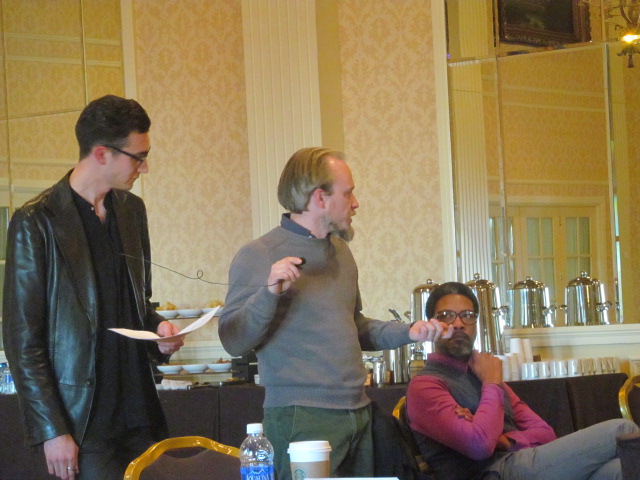
6:00 – 7:00 p.m., Unpacking Curation, Claudia Arzeno and Niki Johnson
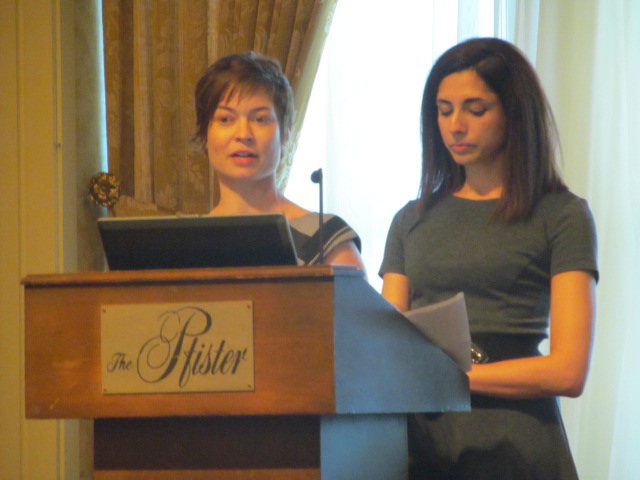
Left to right: Niki Johnson and Claudia Arzeno.
Curator Claudia Arzeno and Niki Johnson made a great, though odd, couple. Niki, she’s a self-proclaimed “DIY curator,” and Claudia has stuck almost exclusively to the bureaucratic museum world. (Currently, she works at the Chipstone Foundation.) Mostly, the duo strike a good balance together, and are really pretty great at breaking down artspeak to a 101 level.
Thesis is everything. Otherwise, it’s just like having a beer with friends. — Niki Johnson
Here’s a really blurry pic from their PowerPoint:
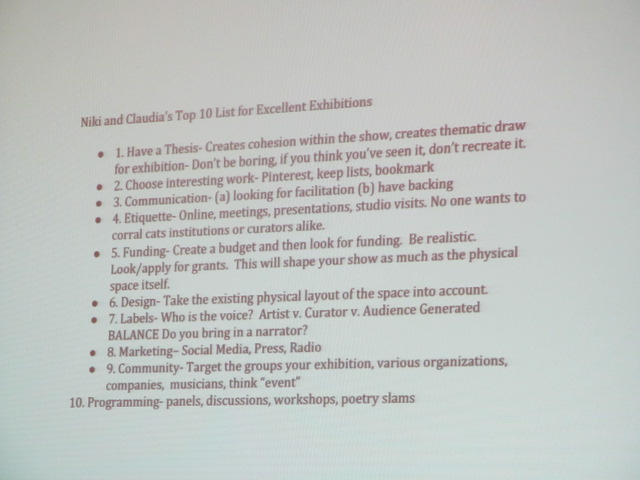
7:00 – 8:00 p.m., The Intersection of Art, Creativity, and Entrepreneurship, Translator
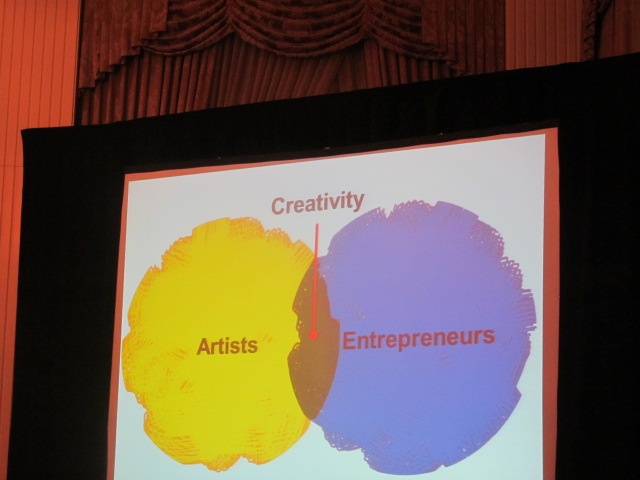
All you need to know about the talk.
8:00 – 9:00 p.m., Manufacturing Creativity, Reggie Baylor
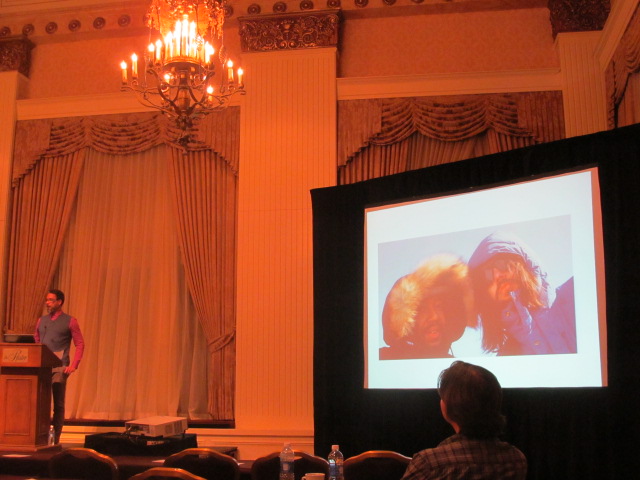
Guys, it’s after 9:00 p.m. in New York. I’m sorry, but my eyes and brain cannot blog at A+ quality any longer. So, artist Reggie Baylor clicked on this photo of Russell Simmons and Rick Rubin because he, like they did, targeted the suburbs and the suburban consumer. The moral: You’ll make money if you focus on Middle America.
Well, that’s one model. Goodnight, Milwaukee!


Comments on this entry are closed.